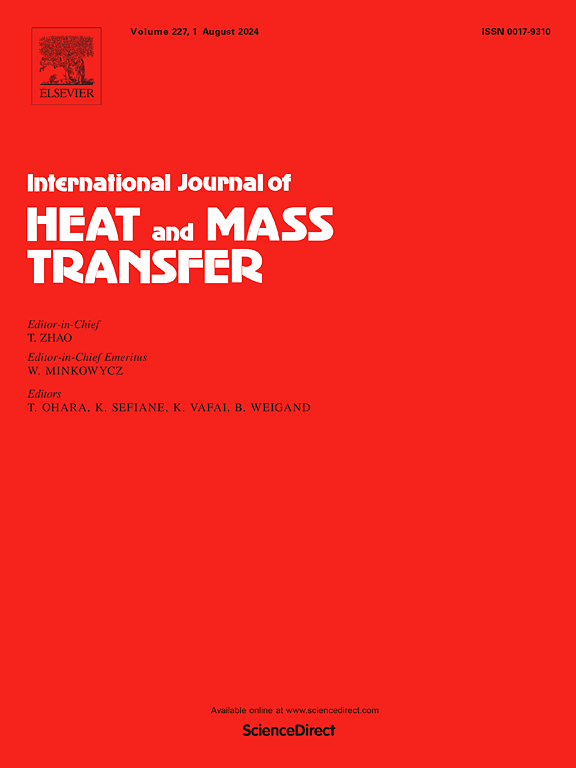通过振动压电-风扇集成增强双冲击射流对流换热
IF 5
2区 工程技术
Q1 ENGINEERING, MECHANICAL
International Journal of Heat and Mass Transfer
Pub Date : 2025-06-25
DOI:10.1016/j.ijheatmasstransfer.2025.127433
引用次数: 0
摘要
本文研究了多射流碰撞系统中压电风扇激励对传热的增强和均匀性。主要目的是分析不同射流距离(L/d)、射流距离(s/d)、射流雷诺数(Rej)和压电风扇配置下的流体动力学和传热性能。非定常数值模拟和实验结果表明,纵向压电风扇结构显著增强了二次驻点的换热,在Rej = 3500、L/d = 6和s/d = 6时,总体换热增强因子(χ)提高了37.5%,换热均匀性(ξ)提高了20.7%。随着L/d的增加,风扇的贡献更加明显,在射流冲击减弱时主导着局部换热。强化效应在层流或过渡状态下最为有效,在Rej = 5000以上,χ和ξ值急剧下降。这些发现突出了压电风扇集成在优化多射流冲击系统以改善和更均匀对流换热方面的潜力。本文章由计算机程序翻译,如有差异,请以英文原文为准。
Convective heat transfer enhancement between dual impinging jets through vibrating piezo-fan integration
This study investigates the enhancement and uniformity of heat transfer in multi-jet impingement systems through piezo-fan excitation. The primary objective is to analyze the fluid dynamics and heat transfer performance under varying jet-to-target distance (L/d), jet-to-jet distance (s/d), jet Reynolds number (Rej), and piezo-fan configurations. Unsteady numerical simulations and experiments reveal that the longitudinal piezo-fan configuration significantly enhances heat transfer at secondary stagnation points, achieving a 37.5% increase in the overall heat transfer enhancement factor (χ) and a 20.7% improvement in heat transfer uniformity (ξ) at Rej = 3500, L/d = 6, and s/d = 6. As L/d increases, the fan’s contribution becomes more pronounced, dominating the local heat transfer when the jet impingement weakens. The enhancement effect is most effective in laminar or transitional regimes, with χ and ξ decreasing sharply beyond Rej = 5000. These findings highlight the potential of piezo-fan integration in optimizing multi-jet impingement systems for improved and more uniform convective heat transfer.
求助全文
通过发布文献求助,成功后即可免费获取论文全文。
去求助
来源期刊
CiteScore
10.30
自引率
13.50%
发文量
1319
审稿时长
41 days
期刊介绍:
International Journal of Heat and Mass Transfer is the vehicle for the exchange of basic ideas in heat and mass transfer between research workers and engineers throughout the world. It focuses on both analytical and experimental research, with an emphasis on contributions which increase the basic understanding of transfer processes and their application to engineering problems.
Topics include:
-New methods of measuring and/or correlating transport-property data
-Energy engineering
-Environmental applications of heat and/or mass transfer

 求助内容:
求助内容: 应助结果提醒方式:
应助结果提醒方式:


